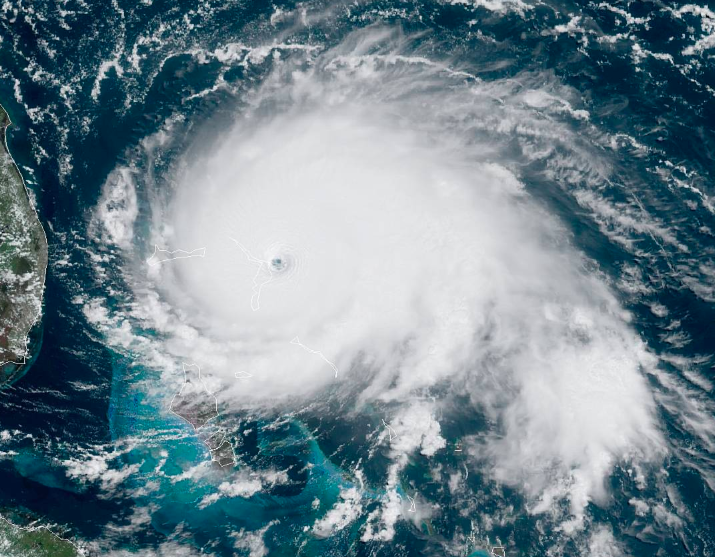Written by Jeff Verardelli / Yale Climate Connections
Major hurricanes are by far the world’s costliest natural weather disasters, in some cases causing well over $100 billion in damage. There’s now evidence that the unnatural effects of human-caused global warming are already making hurricanes stronger and more destructive. The latest research shows the trend is likely to continue as long as the climate continues to warm.
How does a hurricane form?
Whether called hurricanes in the Atlantic Ocean, typhoons in the western Pacific Ocean, or cyclones in the Indian Ocean, strong tropical cyclones are an example of nature’s fiercest fury.
The criteria that conspire to form tropical cyclones are rather simple. It all starts with a small atmospheric disturbance located in or near a tropical ocean. If water temperatures are warm enough, generally more than 80 degrees Fahrenheit, and atmospheric conditions are supportive with moisture and uniform winds, a tropical system can evolve. In the Atlantic the system first becomes a tropical depression. As it gets stronger the system graduates to a tropical storm and then finally, when winds rise over 74 mph, it is termed a hurricane.
Are hurricanes becoming more frequent?
Generally speaking, the warmer the water temperatures, the more heat energy is available and the higher the potential for tropical cyclones to develop. So it’s reasonable to assume that as humans continue to release planet-warming greenhouse gases, the likelihood of tropical cyclone activity increases.
By and large, that is true, but in the real world it’s a little more complicated than that. The conventional wisdom is that storm intensity will increase but storm frequency will either decrease or remain unchanged.
Finding trends in either the number or intensity of tropical cyclones is complicated because reliable records date back only as far as consistent and complete global satellite observations. Since 1985, a remarkably consistent average of approximately 80 tropical cyclones has formed each year, ranging from a low of 65 to a maximum of 90.
In terms of frequency, studies have consistently shown “no discernible trend in the global number of tropical cyclones.” In addition, authors of a 2013 study found no human-caused signal in annual global tropical cyclone or hurricane frequencies.
Are hurricanes getting stronger?
The authors of that same 2013 study found a substantial regional and global increase in the proportion of the strongest hurricanes—category 4 and 5 storms. The authors attribute that increase to global heating of the climate: “We conclude that since 1975 there has been a substantial and observable regional and global increase in the proportion of Cat 4–5 hurricanes of 25–30 percent per °C of anthropogenic (human-caused) global warming.”
Interestingly, the increase in those most powerful of storms is balanced by a similar decrease in category 1 and category 2 hurricanes. The authors put forth this intriguing theory: “We suggest that this [balance] arises from the capped nature of tropical cyclones to a maximum value defined by the potential intensity, which increases only slightly with global warming.”
Are hurricanes intensifying more rapidly?
Rapid intensification, defined as an increase of wind speed of at least 35 mph in 24 hours, has recently garnered a lot of attention as a result of hurricanes like Harvey, Irma, Maria and Michael in 2017 and 2018. Examining the hurricane record in the Atlantic basin from 1986 to 2015, a recent study found rapid intensification increased 4.4 mph per decade. The study’s authors attribute most of the gains to a shift into the warmer phase of the Atlantic Multidecadal Oscillation, a natural cycle.
But the authors of a 2019 paper led by scientists at NOAA’s Geophysical Fluid Dynamics Laboratory suggest that global warming also plays a role. Using simulations from one of the most advanced climate models available, called HiFLOR, the team of researchers concludes that recent increases in rapid intensification “is outside HiFLOR’s estimate of expected internal climate variability which suggests the model’s depiction of climate oscillations like the AMO cannot explain the observed trend.”
So while the team cannot attribute the rapid intensification gains to human-caused warming, they do say human-caused warming significantly increases extreme tropical cyclone intensification rates in the HiFLOR model.
Are hurricanes producing more rain?
When it comes to the link between a warming world and weather, one of the most well-understood and robust connections is increased rainfall. Simply put, the warmer the air is, the more moisture it can hold and the more rain it produces. Generally, the increase in rainfall follows the Clausius-Clapeyron equation, which dictates that for every one degree Celsius (1.8 degrees Fahrenheit) increase, the atmosphere can hold 7% more moisture.
This increase in moisture and rainfall does not fall uniformly; in tropical cyclones this effect is boosted. In a 2018 paper about the link between increasing ocean heat content and hurricanes, lead author Kevin Trenberth of the National Center for Atmospheric Research explains that “the convergence of moisture into a storm not only leads to higher precipitation but also, for certain storms, greater intensity and growth.” So we can see that a combination of warmer air and water lead to increases in rainfall beyondthe simple Clausius-Clapeyron relationship.
A good example of that is the unprecedented 60 inches of rain that fell in 2017 in southeast Texas in Hurricane Harvey. Researchers have concluded that a repeat of rainfall that intense is predicted to happen only once every 9,000 years. A majority of the rain was caused by Harvey’s extremely slow movement. But multiple attribution studies conclude that a significant amount of rain can be traced to human-caused warming, with various estimates ranging from 15% to 20% to 38%. Using the term “biblical” to describe Harvey’s rainfall, MIT’s Kerry Emanuel calculates a six-fold increase in the probability of an event of that magnitude since just the late 20th century.
A team investigating extreme rainfall in Hurricane Maria reached a similar conclusion: “[E]xtreme precipitation, like that of Hurricane Maria, has become much more likely in recent years and long‐term trends in atmospheric and sea surface temperature are both linked to increased precipitation in Puerto Rico.” That paper finds the probability of rainfall of Maria’s magnitude has increased by a factor of almost five in the most heavily impacted areas.
Does climate change affect the forward speed of hurricanes?
Some climate scientists theorize that slower steering currents resulting from a warmer climate may have contributed to Harvey’s lethargic movement. At this point, that question remains unanswered.
But a 2018 study by NOAA’s James Kossin discovered a 10% global reduction in forward speed of tropical cyclones since 1949. Even more concerning—because of the impact on flooding—is the heightened slowdown detected over land areas: 21% in the western north Pacific and 16% in the North Atlantic. Authors of another study support these concerns, finding a significant positive trend over the past several decades in coastal rainfall from tropical cyclones that stall. That study does not, however, reach a conclusion on the reason for the increased stalling.
Will hurricanes become more common in the future?
In a comprehensive 2015 paper, lead author Thomas Knutson of NOAA GFDL and co-authors examined a middle-of-the-road warming scenario using computer model simulations. Along with many other studies, their projections show a general future decrease in the overall number of tropical cyclones.
This decrease in number of storms is generally believed to be a byproduct of increasing wind shear—hostile environmental winds—expected in the tropics. But there may be another, more significant reason for the anticipated decrease in storm number.
According to Emanuel of MIT, an increase in saturation deficit of the atmosphere at cloud level is the culprit identified on model simulations. In simpler terms, the saturation deficit just means the atmosphere has a tougher time reaching its capacity of moisture.
While many models do forecast a decrease in number, Emanuel’s 2013 study, using a higher-end warming scenario, found that the frequency of tropical cyclones increased in most locations. And that study is not alone. A more recent study Kieran Bhatia from NOAA GFDL, using the high-resolution HiFLOR model, shows a global increase in storm frequency of 9% and a 23% increase in the Atlantic basin by the end of the 21st century.
When asked about the conflicting research findings on cyclone frequency, Emanuel said by email: “My own view is that we really do not know at this point whether the overall global frequency of [tropical cyclones] will increase, decrease, or stay the same. It is an area of active research.”
But Emanuel stresses that the frequency metric is dominated by weak storms that typically do not do much damage, making frequency much less consequential than nailing down future intensity and rainfall.
“There is a strong consensus in the tropical cyclone climate community that the incidence of high-category events will increase, and that storms will precipitate more,” Emanuel said.
Will hurricanes become more intense in the future?
According to NOAA, 85% of all damages from hurricanes come from category 3, 4, and 5 storms. That’s the case in part because of their intense winds. Incredibly, a hurricane with 150-mph wind speed has 256 times the damage potential of a hurricane with 75-mph winds.
In a 2015 paper using future model simulations, Knutson found an “increase in average cyclone intensity, precipitation rates, and the number and occurrence days of very intense category 4 and 5 storms.” Specifically, the simulations calculated a 28% increase in category 4 and 5 storms globally, with a 335% increase in the northeast Pacific and a 42% increase in the North Atlantic.
In Bhatia’s 2018 study, the intensity gains are even more alarming. The HiFLOR simulations project the number of major cyclones (category 3, 4, and 5) to increase by 20% globally and 29% in the Atlantic by 2081-2100. But HiFLOR suggests a significant increase in major systems even sooner.
The numbers really spike when isolating just category 5 storms, with an 85% global jump and 136% Atlantic basin leap. Of these findings, Bhatia says, “HiFLOR climate change experiments signal that tropical cyclones will more routinely reach wind speeds that are well above the category 5 threshold, hinting that the Saffir–Simpson scale might need to be extended to include higher categories in the early 21st century.”
How will hurricane rainfall change in the future?
Projections of future rainfall increases in tropical cyclones are also notable. Knutson’s study finds a global rain rate increase of 14% by the end of the 21st century.
Emanuel’s 2017 study of Hurricane Harvey calculates that hurricane rains of 20 inches in Texas will evolve from a once-in-100-year event at the end of the 20th century to a once-in-5.5-year occurrence by 2100. Given that the vast majority of damage from storms like Hurricanes Harvey and Florence come from rainfall, these findings raise concerns.
Will hurricanes intensify more rapidly in the future?
Rapid intensification is one of the least well-predicted tropical cyclone processes and also one of the most dangerous, because storms that intensify quickly tend to catch people off guard. Rapid intensification is another aspect of tropical cyclones characterized by broad agreement among researchers.
Along with various aspects of intensity, the 2018 HiFLOR study “signals that climate change could allow TCs [tropical cyclones] to rapidly intensify over a larger portion of the world’s oceans and increase TC intensification rates dramatically.”
A 2017 paper by Kerry Emanuel finds that “the incidence of storms that intensify rapidly just before landfall increases substantially as a result of global warming.” To illustrate just how large the changes are, Emanuel quantifies them: “These results suggest that a storm that intensifies 70 mph in the 24 hours just before landfall, occurring on average once per century in the climate of the late twentieth century, may occur every 5–10 years by the end of this century.”
Is there a danger to people or property?
Given the expected boost in intense cyclones, society faces growing threats. With a combination of stronger storms, sea-level rise, increased coastal populations, and infrastructure exposure, damages and disruptions will continue to mount.
Since 1970, the global population exposed to tropical cyclone hazards has increased threefold—a figure expected to continue to increase over the next few decades. Tropical cyclone damages, adjusted for inflation, are rising by approximately 6% per year since 1970.
The vast majority of deaths are caused by the most lethal storm systems, and in fact more than half of tropical cyclone-related deaths in the U.S. since 1900 have been caused by just three storms. Although those mortality numbers are decreasing because of better warnings and preparation, it is easy to see that a future with more intense storms will cause more serious societal impacts.
Storm surge is one the deadliest aspects of landfalling tropical systems, responsible for nearly 50% of deaths since 1963. Experts estimate that global sea-level will risebetween a couple to a few feet by the end of the century. In itself, even without stronger cyclones, sea-level rise will cause exponential damages and exposures.
In a prophetic paper published just before Hurricane Sandy, four researchers warned that sea-level rise and changes in storm climatology would increase the risk of disastrous floods in New York City. Specifically, they calculated that a present-day 1-in-100-year flood will occur once every three to 20 years, and a 500-year flood will happen once every 25-240 years by 2100.
A warmer climate will also bring some shifts in storm locations. For example, the authors of a 2014 paper discovered that tropical systems increasingly are reaching maximum intensity farther north or south from the equator as warmer waters expand towards the North and South Poles. In the Atlantic basin, this prospect puts areas of the U.S. northeast coast and maritime Canada in greater danger of a stronger hurricane.
This recent paper also forecasts an elevated threat of land-falling tropical cyclones in Taiwan, the Philippines, Hawaii, and the southeastern United States.
Using 21st-century climate model projections, a more recent study led by Mingfang Ting of Columbia University concludes that human-caused warming may lead to a weakening of disruptive vertical wind shear during active Atlantic hurricane cycles. Recall that “wind shear” refers to hostile environmental winds that act as a barrier to storms, helping to weaken and sometimes steer storms away from land. If this research pans out, wind shear will be less able to weaken future storms along the U.S. East Coast during periods of heightened hurricane activity.
This weakening of wind shear is likely to result in more rapid intensification of storms as they near landfall. On a massively populated coast with a heavily built environment, this combination will be dangerous and destructive.
Assessing the risk from both wind and storm surge, the author of a 2017 paperconcludes: “In combination, climate change and coastal development will cause hurricane damage to increase faster than the U.S. economy is expected to grow. In addition, we find that the number of people facing substantial expected damage will, on average, increase more than eight-fold over the next 60 years.”
It’s clear from the research presented above that threats from tropical systems, and in particular from the most intense cyclones, are increasing. This trend will continue for the foreseeable future. Although some of these anticipated impacts are already baked into our warmer climate, the most serious escalations can still be averted. The only remedy is a rapid decarbonization of our economy and a society that is better prepared for threats coming our way.
Jeff Berardelli is a meteorologist and climate contributor to CBS News in New York City.














